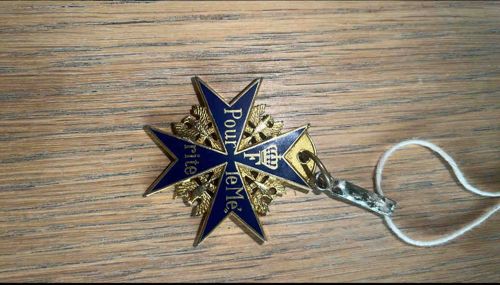
Pour le Mérite (Blue Max)
The item depicted is a Pour le Mérite, often referred to as the 'Blue Max,' which was the Kingdom of Prussia's highest military order until the end of World War I. It is a Maltese cross-shaped medal, clearly visible with four arms terminating in points, enameled in a deep, rich cobalt blue that stands out against the gold-toned metalwork underneath. The edges of the arms are outlined in gold, which is also the color of the scrollwork and intricate 'sunburst' or radiant design visible between the arms of the cross, adding to its ornate appearance. In the center of the cross, on the horizontal arms, the inscription 'Pour le Mérite' is visible in gold lettering, distributed as 'Pour' on the left arm, 'le' on the top arm, and 'Mérite' on the right arm. The top vertical arm also displays a gold royal or imperial crown motif, signifying its Prussian origins, while the bottom vertical arm likely bears the royal cypher of Frederick the Great (F.W.R.), though it is not clearly legible from this angle. The medal appears to be constructed from gilded metal and enamel, typical materials for such an honor. The craftsmanship appears to be of high quality, with precise enamel application and detailed metalwork suggesting an official issue. Visible condition shows some typical wear consistent with age, particularly on the gold-toned areas, which might display minor tarnishing or dulling. The enamel appears largely intact with no obvious chips or cracks visible from this perspective. It is attached to some form of modern-looking clip and string, which might indicate it is being handled or displayed, or perhaps is part of a modern storage or display system, and is not original to the medal's suspension. Given its historical context, this item dates from the period of the Kingdom of Prussia, predominantly from the 18th century through 1918.
AI-Generated Appraisal Disclaimer
Estimated Value
$5,000-$15,000 (Conditional - Awaiting Physical Authentication & Provenance)
Basic Information
Category
Military Order/Decoration
Appraised On
November 28, 2025
Estimated Value
$5,000-$15,000 (Conditional - Awaiting Physical Authentication & Provenance)
Additional Details Provided By Owner
User Provided Information
The missing pour le merite that disappeared from Germany that is said to be owned by Noah Dohme that is the emperor of Lixland which is 75 million square kilometers owned by Noah Dohme the emperor of Lixland which is 18 years old the supreme general of Lixland and the emperor of Lixland
Item Description
The item depicted is a Pour le Mérite, often referred to as the 'Blue Max,' which was the Kingdom of Prussia's highest military order until the end of World War I. It is a Maltese cross-shaped medal, clearly visible with four arms terminating in points, enameled in a deep, rich cobalt blue that stands out against the gold-toned metalwork underneath. The edges of the arms are outlined in gold, which is also the color of the scrollwork and intricate 'sunburst' or radiant design visible between the arms of the cross, adding to its ornate appearance. In the center of the cross, on the horizontal arms, the inscription 'Pour le Mérite' is visible in gold lettering, distributed as 'Pour' on the left arm, 'le' on the top arm, and 'Mérite' on the right arm. The top vertical arm also displays a gold royal or imperial crown motif, signifying its Prussian origins, while the bottom vertical arm likely bears the royal cypher of Frederick the Great (F.W.R.), though it is not clearly legible from this angle. The medal appears to be constructed from gilded metal and enamel, typical materials for such an honor. The craftsmanship appears to be of high quality, with precise enamel application and detailed metalwork suggesting an official issue. Visible condition shows some typical wear consistent with age, particularly on the gold-toned areas, which might display minor tarnishing or dulling. The enamel appears largely intact with no obvious chips or cracks visible from this perspective. It is attached to some form of modern-looking clip and string, which might indicate it is being handled or displayed, or perhaps is part of a modern storage or display system, and is not original to the medal's suspension. Given its historical context, this item dates from the period of the Kingdom of Prussia, predominantly from the 18th century through 1918.
Get Your Items Appraised
Instant estimates of your treasures with AI-powered instant appraisals